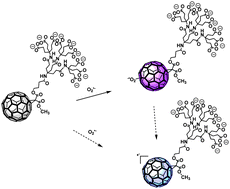Reaction of water-soluble fullerenes with O2˙− and other reactive radical species†
Abstract
In this work we focused on the reaction of

- This article is part of the themed collection: 20th anniversary starts here!
Maintenance work is planned for Wednesday 1st May 2024 from 9:00am to 11:00am (BST).
During this time, the performance of our website may be affected - searches may run slowly and some pages may be temporarily unavailable. If this happens, please try refreshing your web browser or try waiting two to three minutes before trying again.
We apologise for any inconvenience this might cause and thank you for your patience.
* Corresponding authors
a
Department of Chemistry and Pharmacy & Interdisciplinary Center of Molecular Materials (ICMM), Friedrich-Alexander-Universität Erlangen-Nürnberg, Erlangen, Germany
E-mail:
guldi@chemie.uni-erlangen.de
Fax: +49 9131 8527340
Tel: +49 9131 8527340
b
Department of Chemistry and Pharmacy & Interdisciplinary Center of Molecular Materials (ICMM), Friedrich-Alexander-Universität Erlangen, Erlangen, Germany
E-mail:
andreas.hirsch@chemie.uni-erlangen.de
Fax: +49 9131-852-6864
Tel: +49 9131 8522537
In this work we focused on the reaction of

 Please wait while we load your content...
Something went wrong. Try again?
Please wait while we load your content...
Something went wrong. Try again?
A. Kahnt, D. M. Guldi, M. Brettreich, U. Hartnagel and A. Hirsch, J. Mater. Chem., 2010, 20, 83 DOI: 10.1039/B917346N
To request permission to reproduce material from this article, please go to the Copyright Clearance Center request page.
If you are an author contributing to an RSC publication, you do not need to request permission provided correct acknowledgement is given.
If you are the author of this article, you do not need to request permission to reproduce figures and diagrams provided correct acknowledgement is given. If you want to reproduce the whole article in a third-party publication (excluding your thesis/dissertation for which permission is not required) please go to the Copyright Clearance Center request page.
Read more about how to correctly acknowledge RSC content.
 Fetching data from CrossRef.
Fetching data from CrossRef.
This may take some time to load.
Loading related content
